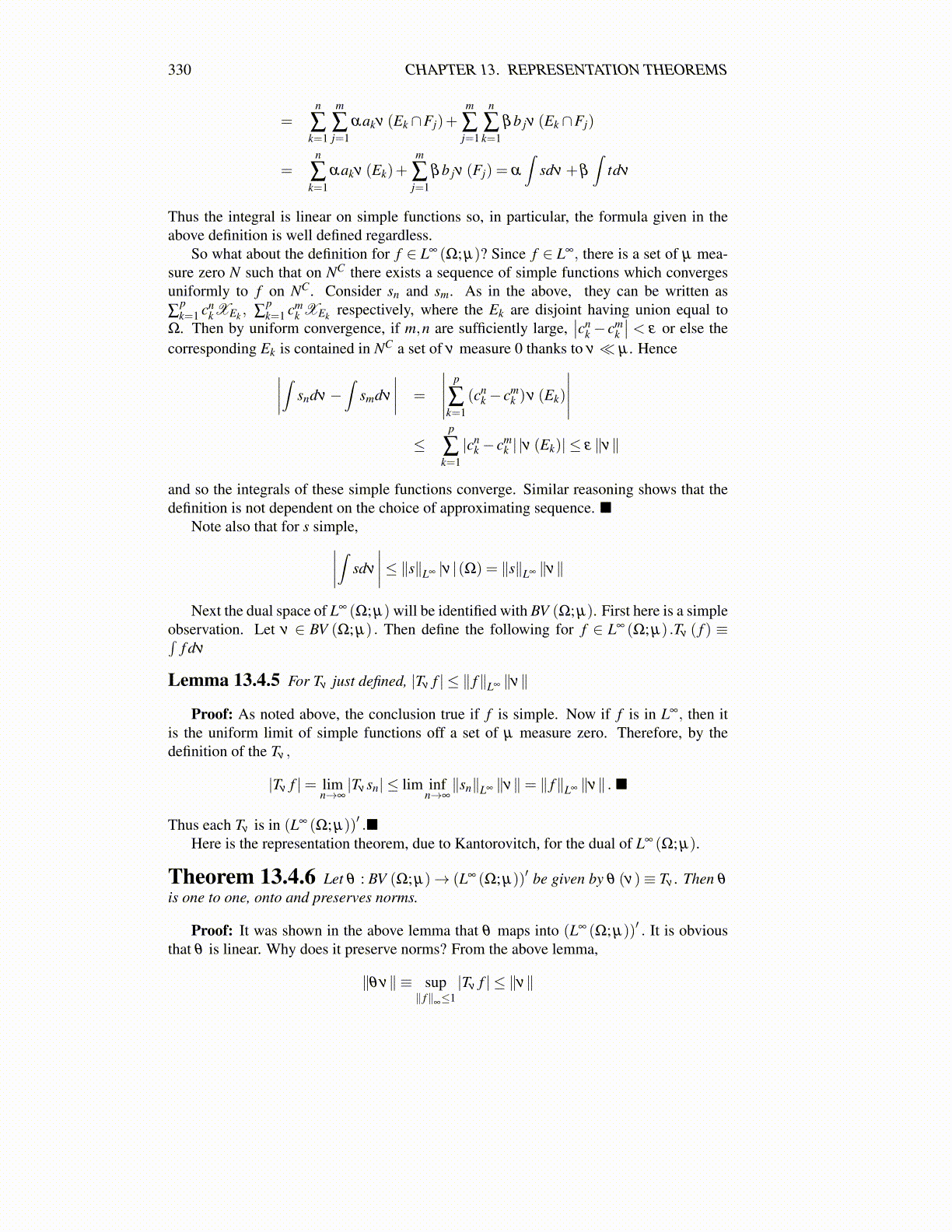
330 CHAPTER 13. REPRESENTATION THEOREMS
=n
∑k=1
m
∑j=1
αakν (Ek ∩Fj)+m
∑j=1
n
∑k=1
βb jν (Ek ∩Fj)
=n
∑k=1
αakν (Ek)+m
∑j=1
βb jν (Fj) = α
∫sdν +β
∫tdν
Thus the integral is linear on simple functions so, in particular, the formula given in theabove definition is well defined regardless.
So what about the definition for f ∈ L∞ (Ω; µ)? Since f ∈ L∞, there is a set of µ mea-sure zero N such that on NC there exists a sequence of simple functions which convergesuniformly to f on NC. Consider sn and sm. As in the above, they can be written as∑
pk=1 cn
kXEk , ∑pk=1 cm
k XEk respectively, where the Ek are disjoint having union equal toΩ. Then by uniform convergence, if m,n are sufficiently large,
∣∣cnk− cm
k
∣∣ < ε or else thecorresponding Ek is contained in NC a set of ν measure 0 thanks to ν ≪ µ . Hence∣∣∣∣∫ sndν−
∫smdν
∣∣∣∣ =
∣∣∣∣∣ p
∑k=1
(cnk− cm
k )ν (Ek)
∣∣∣∣∣≤
p
∑k=1|cn
k− cmk | |ν (Ek)| ≤ ε ∥ν∥
and so the integrals of these simple functions converge. Similar reasoning shows that thedefinition is not dependent on the choice of approximating sequence. ■
Note also that for s simple,∣∣∣∣∫ sdν
∣∣∣∣≤ ∥s∥L∞ |ν |(Ω) = ∥s∥L∞ ∥ν∥
Next the dual space of L∞ (Ω; µ) will be identified with BV (Ω; µ). First here is a simpleobservation. Let ν ∈ BV (Ω; µ) . Then define the following for f ∈ L∞ (Ω; µ) .Tν ( f ) ≡∫
f dν
Lemma 13.4.5 For Tν just defined, |Tν f | ≤ ∥ f∥L∞ ∥ν∥
Proof: As noted above, the conclusion true if f is simple. Now if f is in L∞, then itis the uniform limit of simple functions off a set of µ measure zero. Therefore, by thedefinition of the Tν ,
|Tν f |= limn→∞|Tν sn| ≤ lim inf
n→∞∥sn∥L∞ ∥ν∥= ∥ f∥L∞ ∥ν∥ . ■
Thus each Tν is in (L∞ (Ω; µ))′ .■Here is the representation theorem, due to Kantorovitch, for the dual of L∞ (Ω; µ).
Theorem 13.4.6 Let θ : BV (Ω; µ)→ (L∞ (Ω; µ))′ be given by θ (ν)≡ Tν . Then θ
is one to one, onto and preserves norms.
Proof: It was shown in the above lemma that θ maps into (L∞ (Ω; µ))′ . It is obviousthat θ is linear. Why does it preserve norms? From the above lemma,
∥θν∥ ≡ sup∥ f∥∞≤1
|Tν f | ≤ ∥ν∥